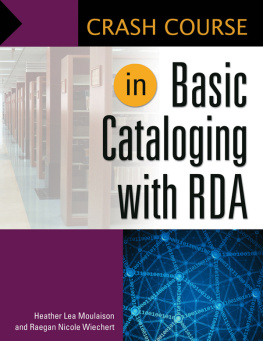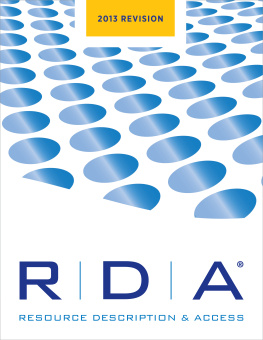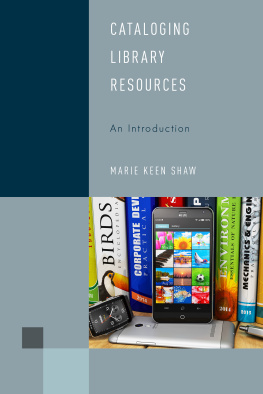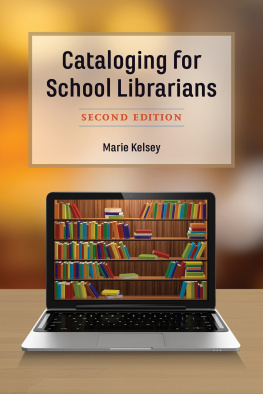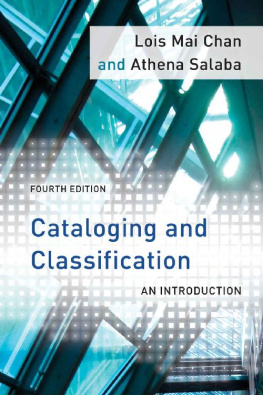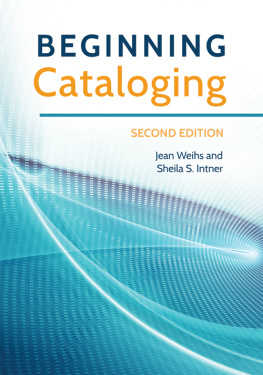Crash Course in Basic Cataloging with RDA
Recent Titles in Libraries Unlimited
Crash Course Series
Crash Course in Public Library Administration
Wayne Disher
Crash Course in Genealogy
David R. Dowell
Crash Course in Family Literacy Programs
Rosemary Chance and Laura Sheneman
Crash Course in Services for Seniors
Ann Roberts and Stephanie G. Bauman
Crash Course in Strategic Planning
Stephen A. Matthews and Kimberly D. Matthews
Crash Course in Gaming
Suellen S. Adams
Crash Course in Dealing with Difficult Library Customers
Shelley E. Mosley, Dennis C. Tucker, and Sandra Van Winkle
Crash Course in Childrens Services, Second Edition
Penny Peck
Crash Course in Collection Development, Second Edition
Wayne Disher
Crash Course in Marketing for Libraries, Second Edition
Susan W. Alman and Sara Gillespie Swanson
Crash Course in Readers Advisory
Cynthia Orr
Crash Course in Storytime Fundamentals, Second Edition
Penny Peck
Crash Course in Basic Cataloging with RDA
Heather Lea Moulaison and Raegan Wiechert
Crash Course

Copyright 2015 by Heather Lea Moulaison and Raegan Wiechert
All rights reserved. No part of this publication may be reproduced, stored in a retrieval system, or transmitted, in any form or by any means, electronic, mechanical, photocopying, recording, or otherwise, except for the inclusion of brief quotations in a review, without prior permission in writing from the publisher.
Library of Congress Cataloging-in-Publication Data
Moulaison, Heather Lea, author.
Crash course in basic cataloging with RDA / Heather Lea Moulaison and Raegan Wiechert.
pages cm. (Crash course)
Includes bibliographical references and index.
ISBN 978-1-4408-3776-0 (paperback) ISBN 978-1-4408-3777-7 (ebook)
1.Cataloging.2.Resource description & access.3.ClassificationBooks. I.Wiechert, Raegan, author.II.Title.
Z693.M682015
025.3'2dc232015017302
ISBN: 978-1-4408-3776-0
EISBN: 978-1-4408-3777-7
191817161512345
This book is also available on the World Wide Web as an eBook.
Visit www.abc-clio.com for details.
Libraries Unlimited
An Imprint of ABC-CLIO, LLC
ABC-CLIO, LLC
130 Cremona Drive, P.O. Box 1911
Santa Barbara, California 93116-1911
This book is printed on acid-free paper 
Manufactured in the United States of America
Contents
Figures
Sidebars
Tables
Cataloging is an integral part of library operations. At the most basic level, libraries must have content, and beyond that, the content must be organized. There are many, many other services libraries offer, but fundamentally, at the heart of it, a library is not a library if it does not provide access to organized content.
Cataloging is how library content is organized. Cataloging is carried out in technical services departments or in other behind-the-scenes operations. Larger libraries might have an entire Cataloging Department as part of its Technical Services unit with fleets of catalogers at the ready, each specialized in a certain area. This book, while a welcome refresher for them perhaps, is not designed for those librarians.
Instead, this Crash Course is intended for librarians and library employees who are not experts and who are left to work through the intricacies of cataloging with little professional guidance. Here, we approach current cataloging from a practical standpoint for non-catalogers. Understanding elements of the cataloging process and record and being able to interact with records in a basic way is the primary focus of this book.
Of course, not all readers will have the same background or the same purpose in picking up this book. Some might be interested in cross-training and might already be working with library technology or in library administration; others might find themselves suddenly responsible for a librarys cataloging and need to find a reasonable point of departure for carrying out their work. Students taking Cataloging at the associate or masters level will be able to use this book as a practical supplement to their course books; additionally, courses in Technical Services librarianship or Organization of Information at the masters level might find it a useful textbook for the Cataloging module.
This little guide is an up-to-date resource that will enable those interested in cataloging, but who do not come to it with a weighty cataloging background, to understand cataloging in the current RDA environment. With the advent of new web technologies, all aspects of cataloging are rapidly evolving, and new thinking is required. New terms, new tools, and new approaches have also followed the adoption of the content standard, RDA, and this book gives an overview to all of them for those starting out.
How to Read This Book
This book features the kind of information needed to be successful in practical cataloging. We recommend you read it through once, skimming if that makes the most sense. There is a lot here, so you might want to let it sink in a little.
Then, we suggest you go back and reread the parts that are most relevant to what you are trying to accomplish. We supply ample references and resources, many of which are web-based and free. Check out the references and resources associated with the chapters that are the most relevant. All of this reading and surfing will take a fair amount of time on your part, and that is okay. The standard wisdom around libraries used to be that it took three years to learn how to catalog and five years to have it make sense. Please understand that this is a journey, and picking up this book is one of the best ways to have started.
One recommendation, which you may choose to accept or reject, is to work at a computer with the largest screen you can find. In many large libraries, librarians working in the cataloging department were among the first to be outfitted with dual-monitor workstations. This was no accident. In order to catalog correctly, a number of different resources need to be consulted, and many of them are online.
Structure of the Book
This book is organized into 10 chapters. We begin by setting the stage for the cataloging task, then describe the tasks carried out during the cataloging process, and finally situate them in terms of their place in making information available to patrons.
In , we address the big-picture issues in cataloging. We are assuming that you come to this with no background at all in the area, so we give you a bit of a foundation and permit you to understand some of the basic context for cataloging, including the roles of the Library of Congress (LC) and the background to the current cataloging instructions, Resource Description and Access (RDA). We also describe some of the basic notions that are essential to cataloging, including the importance of doing things the same way from library to library in order to enable libraries to share cataloging records.
In , we talk about the computer systems that house and display cataloging records. Standards for encoding are important, and the computer systems, called integrated library systems (ILSs), are where the rubber hits the road. Librarians use these systems to store cataloging records, and patrons use them or more user-friendly interfaces, to search for those records. This chapter also addresses issues of how the catalog is searched, and how local practice might be taken into consideration when cataloging.

